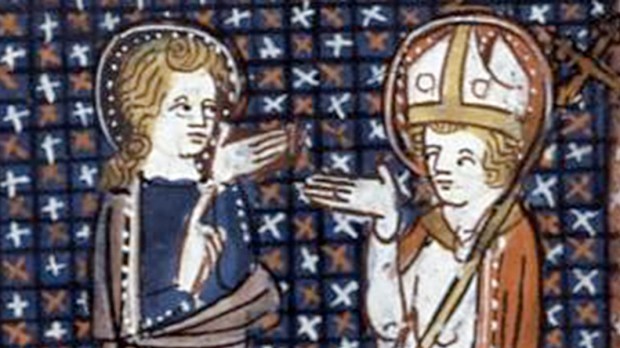In this time of great division, it’s important to remember that it’s possible to disagree without being hateful. It’s possible that two people take different positions on a matter of prudential judgment and both are holy. It’s even possible for people who were previously vicious in their conflict to be converted, either to the position of their opponent or just to charitable disagreement. The Saints, as always, show us the way.
St. Oscar Romero (1917-1980) and Venerable Rutilio Grande (1928-1977) were an unlikely pair of friends. Though a diocesan priest, Romero lived with the Jesuit community in San Salvador for a few years before being appointed auxiliary bishop. Romero was famously standoffish at the time, but he and Grande got along very well, despite their political and liturgical differences. Grande had progressive preferences in liturgy while Romero was much more traditional. Grande was very politically involved, fighting for the rights of the poor, while Romero was content (for the time) to ignore the abuses of the right-wing government. Still, the two were so close that when Romero was appointed auxiliary bishop, he asked Grande to help him plan the liturgy. Though they were on opposite ends of the political spectrum, they remained close until Grande’s assassination; it was looking at the dead body of his friend that transformed Romero from a timid and bookish man to the warrior for justice that we know so well. But this conversion was rooted in friendship, possible only because Romero and Grande had been able to love each other well in spite of their differences.

Read more:
Benedict XVI paved way for Oscar Romero’s canonization
St. Philip Neri (1515-1595) was spiritual director to St. Camillus de Lellis (1550-1614). A recovering gambling addict and former mercenary, Camillus required quite a lot of direction in the years after his conversion, when he was living at a hospital (and occasionally leaving to attempt to enter the Capuchins). It’s often said that Camillus chose to found his order with the encouragement of Philip; in fact, Philip was quite certain that Camillus’ new foundation was just another false start driven by his restless nature. More than that, Philip felt it was a threat to his salvation, as the men were planning to live in a disreputable neighborhood haunted by the type of men Camillus had once associated with. Philip refused Camillus his blessing. But Camillus was sure that God was calling him to this work. When he insisted, Philip told Camillus he could no longer be his spiritual director if he persisted in this imprudent plan. So Camillus bade him farewell. They say it was the only time the wise Philip Neri was ever wrong in spiritual direction. The Camillians remain active to this day, and Philip eventually realized his mistake and asked forgiveness of his friend.
St. Nicephorus of Constantinople (758-815) and St. Theodore the Studite (759-826) were public opponents for years. Their conflict began when Nicephorus, the patriarch of Constantinople, readmitted a man to the priesthood after he had officiated at the marriage of the already-married emperor. Though Theodore (himself a priest) insists that he tried to keep quiet as long as he could, eventually he was so scandalized that he began to write publicly in opposition to this. He was accused of schism (largely because he and his companions refused to attend liturgies with the patriarch) but insisted that he continued to love and pray for Nicephorus. His protestations unconvincing, Theodore was banished by the emperor. Some years later, Theodore was brought back by the emperor’s successor. Though he publicly reconciled with Nicephorus, Theodore remained his opponent in many things, such as the death penalty for heretics (Nicephorus for, Theodore against) and the extradition of political refugees (Nicephorus for, Theodore against). In matters of orthodoxy, though, they were united. And when an iconoclast emperor took office, both Nicephorus and Theodore opposed him. They were sent into exile (separately) and died in communion with each other and with the Church.
St. Martin of Tours (316-397) raised St. Brice of Tours (370-444) after Brice was abandoned as a child. Not one for filial piety, an 18-year-old Brice was furious when Martin reprimanded him for owning slaves and amassing wealth, even as a monk and a deacon. He ridiculed Martin as a barbarian and called him “the old fool” to monk and stranger alike. His attitude was so vile that some even believed him to be possessed. But Martin was patient. “If Jesus could come to terms with Judas,” he said, “then I can certainly come to terms with Brice.” After Martin’s death, Brice was (shockingly) made bishop and served halfheartedly for decades, until a false accusation sent him into exile. It was this suffering that converted him, this man who was unconverted by the love of St. Martin of Tours. He returned to his See a changed man, finally transformed by the love of God (and the love of a bishop who had never abandoned him, no matter how much he had deserved it).

Read more:
Watch: Bishop Barron teaches Facebook staff how to argue about religion

